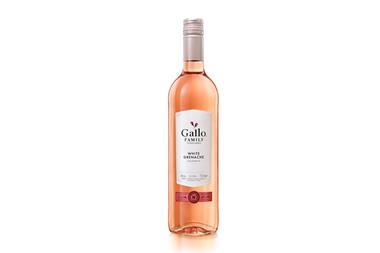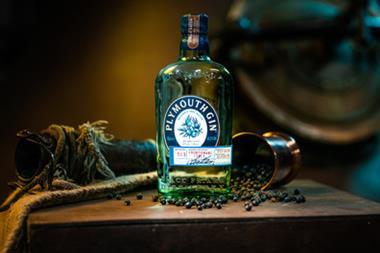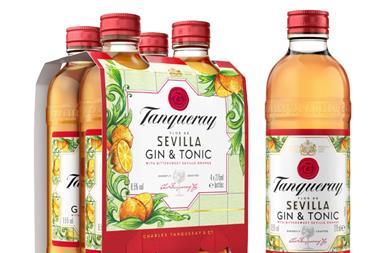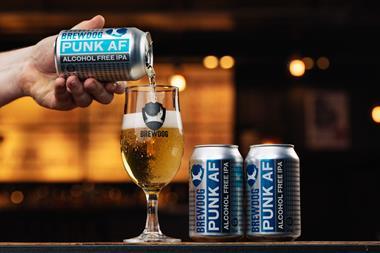Holidays are coming and so is a sparkling opportunity for alcohol. Get it covered with premium spirits, low-alcohol options and lots of fizz.
Every c-store retailer recalls the spirit(s) of Christmas past. It’s those 10.30am cut-price bubbles sought on the way to all-day office parties. The last-minute Christmas Eve “Have we really got enough booze to get through the Queen’s speech?” distress buys, and the “We’d better bring another bottle” impulse wine purchases en route to December festive dinners.
Or at least that used to be the story. However, this Christmas things might be a bit more messy in the lucrative world of c-store booze. For a start, drinking rates among British adults have plunged to their lowest levels in 18 years (Office of National Statistics) making low- and no-alcohol drinks a more mainstream buy. Plus, premiumisation is also driving a ‘less is more’ approach, along with the rise of posh artisan spirits.
But whatever the current trends generating Christmas cheer, one thing’s for sure: local convenience stores are right at the heart of this exciting category.
“About one in five shoppers are likely to buy wine and beer from their local convenience store for the Christmas period, while one in eight choose spirits,” says Alice Dolling, senior analyst at shopper experts HIM.
“Convenience stores need to ensure they are externally communicating the availability of these products in store around the Christmas period, for example with the use of leaflets or digital screens outside the store.”
Dolling explains that this trend is likely to be supercharged at Christmas as consumers continue to choose shops close to them to boost the local community and cut down on eco-unfriendly travelling. It’s a key factor for young consumers with disposable Christmas cash to flash.
“Some 22% of shoppers are looking to purchase their alcohol locally during the Christmas period,” Dolling adds, “and this jumps even further to 28% for shoppers under the age of 34.”
So the seasonal beer, wine and spirits market is ready under the mistletoe, currently waiting for a big kiss. But when should retailers start making the first move?
For Sam Coldbeck, from Wharfedale Premier in Hull, the big marketing push begins just as November is coming to an end.
“In late November we really start driving the marketing,” she says. “We’ll get on Facebook and start advertising our new spirits, and anything else we can see that is doing well on social media. It’s raising awareness: making sure people know the lines that we have in and hitting it really hard with promotions, advertising them in store and on social media.
“Then it’s leaflet delivery the first week of December and looking at the supermarkets to get the best prices on Baileys and those kind of key Christmas lines, such as packs of 18 beers.”
It’s become an unwelcome Christmas tradition for Scrooge-like shoppers to moan that retailers have got seasonal stock in too early. Yet Debbie Deeley, manager at Spar Heskin in Lancashire, believes that you have to get in quick to match the supermarkets.
“The trouble is you’ve got to start stocking early because of what the supermarkets are doing,” she says. “If you don’t keep up with them then you’re losing sales.”
“I think that in convenience stores, customers tend to leave buying alcohol to the last minute, though – round here at least. I just think alcohol is the last thing that everybody buys. People decide how much they’ve got left after food and presents, and then the rest goes on booze.”
Chances are that what a lot of customers will be spending their ready cash on this Christmas is beer. Beer makes up the biggest segment of the £46.5bn alcohol market (Mintel) and is a reliable c-store staple at any time of the year.
Trendy craft beer may be making the big waves in the sector, but the traditional big names also have a part to play in boosting Christmas profits.
Sam has found that offering ready-to-go chilled beer helps set her range apart from what’s in the supermarkets.
“We’ve actually started chilling four-packs of beer,” she says.
“We’ve just taken on a new three-metre chiller for the wine, which has opened up a bit more space in the beer chiller. The 18-packs of beer we stack out on the shop floor.
“Basically, this Christmas people can come in and buy wine, cider and beer – and it’s all chilled and ready to enjoy. We’re advertising that fact on social media, because it’s one thing that gives us a massive boost above the local supermarkets, the fact that ours are ready to drink.”
Reaching out to a younger audience
Concha y Toro has launched a raft of new products targeting young adults in the run-up to Christmas.
Wine-based flavoured drink Jacked boasts a distinctive tear-away label, which aligns with the brand’s ‘tearing up tradition’ slogan.
The company claims that the product is the result of a long research and development process to identify the types of drinks that younger adult drinkers will find more engaging.
Aimed at 22- to 29-year-olds, who are reluctant to open a 75cl bottle of wine, Jacked comes in a 50cl bottle in sophisticated sauvignon blanc with ginger; and rosé with lychee flavours (rrp £5).
The firm is also releasing three new premium wines. Diablo is from the producers of Casillero del Diablo and is a dark red blend.
“This wine is much more about occasion and making a statement with wine,” says Laurie Billson, head of customer marketing. “Diablo retails for £10 and we’re expecting it to sell really well for younger adult wine shoppers looking for something really engaging to take to a party or dinner.”
Next is 1000 Stories, a zinfandel from California which is aged in old bourbon barrels to give it a warm, distinctive flavour. And finally, Adorada is a premium rosé, also from California, which comes in a bottle with a hand-dipped wax seal. “This wine will appeal to gift purchasers looking for something really stylish,” says Billson.
Double bubble
Despite a few murmurs in the press about reaching ‘peak prosecco’ earlier this year, retailers are still planning to get behind the bubbles at Christmastime.
And research reveals that they’re right to give it a pop: Mintel reports that today more consumers than ever before are choosing sparklers over traditional Champagne. Plus, prosecco drinkers skew towards the more affluent end of the spectrum – providing plenty of opportunities to raise basket spend.
“Prosecco has definitely already taken over from Champagne for us,” says Debbie. “This year it’s going to be massive, because our, sorry I can’t pronounce it [she’s talking about Spar’s tongue-twisting Prosecco Valdobbiadene DOCG] has been winning all the awards going. That’s part of our 12 Deals of Christmas promotions this year, and it’s an absolutely cracking deal. I’m not going to tell you what it is yet – you’ll just have to wait!”
Debbie is crystal clear about what gives prosecco its sales fizz – the effervescent price.
“People have got a bit less money these days – and it’s a winner because you can get a cracking prosecco for less than half the price of Champagne, can’t you?” she says.
Price is going to be an all-important factor in the wine category this season, since Brexit-related fluctuations in sterling have pushed it ever upwards in the UK. This puts pressure on retailers to sell prosecco at a discount, as customers now expect it to be on a deal at all times.
Sam says that it has definitely become a promotionally-driven drink. She adds that as hers is not the kind of shop that can do anything over a tenner, as long as it’s on a good promotion it’s a strong seller. “If we can hang it out at £7.50 then absolutely brilliant – it’s dead on the money,” she explains.
“We’ve got three different types of prosecco in at the moment and the one that’s on promotion still sells the best.”
She adds that since volume is key, it’s essential to give customers fresh ideas on how they can use the sparkling stuff in Christmas tipples, in order to drive sales.
“It can be mixed with spirits, so it’s good to give people cocktail ideas,” she says. “It’s letting people know it’s a good idea to have a couple of bottles in at Christmas and you can make all sorts of different drinks with it.”
Aside from prosecco, Debbie reckons that people don’t mind splashing a bit more on a nice bottle of wine for Christmas parties or for dinner on the big day.
“It’s very much about the upgrade at Christmas,” she says. “Rather than go for that £5 or £6 bottle of pinot grigio, maybe they’ll upgrade to a nice chablis for about a tenner. Quite often customers tend to go for the red Bordeaux we do at Christmas as well.”
Once a country infamous for being awash in booze, over the past year growing health awareness, rising prices and falling income have all made the UK a slightly more sober place.
According to Mintel, about a fifth of adults say they didn’t drink alcohol in the three months to November 2017, while 15% claim they don’t drink in a typical week.
Heineken fully expects 2018 to be the biggest year ever for sales of the low- and no-alcohol category – a surge driven by the rise of health-conscious shoppers looking to moderate their drinking, while still feeling part of the celebrations.
Toby Lancaster, category & shopper market director for Heineken UK, says: “No- and low-alcohol is a really exciting and booming area of the category; it is in huge growth (up 19%) and delivering significant value to the off-trade with the sub-category now worth £58m. Occasions such as Dry January, with 4.5 million people taking part, as well as the fact that one in five UK adults are now teetotal, means there is ample opportunity for retailers to harness additional sales from shoppers who are keen to ‘live better’ without compromising on taste.”
Heineken 0.0 has swiftly become the fastest-growing brand in the segment, adding 221,000 shoppers to the category with 47% of 0.0 growth incremental to it, claims the firm. It says that the drink is well-suited to designated drivers, post-work weekday parties and those simply looking to be more mindful during the busy Christmas calendar.
As such, Lancaster advises: “Retailers should consider stocking no- or low-alcohol options and deploy clear signage and education to help shoppers navigate to zero zones in store. In doing so retailers can unlock a new revenue stream by meeting the increased demand for healthier options as well as expanding beer and cider into new occasions.”
Elsewhere, people are choosing to drink less but spend more, fuelling what Mintel calls a “quality over quantity mindset” among consumers – especially in key sectors such as spirits. As Sam explains, that’s fantastic for achieving higher margins.
“On alcohol you’re looking at 7-8% margins, which isn’t lots when you’re trying to make a living,” she says. “However, we’re looking at returning about 20-25% on a lot of premium spirits. That makes a hell of a difference to us.
“With the premium spirits we’re beating the supermarkets on availability and the newness of the product. So shoppers won’t go to the supermarket and buy their usual 18 beers which are probably the same price as ours. They’ll come in to do a full shop, get their spirits and their lagers – so we’re capturing the full trade.”
Sam says there are some great alcohol products on the market at the moment that are really capturing people’s attention.” She is currently singing the praises of the Peaky Blinder range from craft brewery Sadler’s. It includes rum, gin and Irish whiskey lines, which capitalise on the grubby glamour of the BBC’s hit gangster show, offering the uniqueness that gives Sam’s store the edge.
“We’re looking for spirits that capture people’s attention on social media, and offer people something different to what they can get elsewhere in our local area,” she says. “Lines such as the Manchester Gin are doing really well.”
The continuing gin craze has also fuelled growth for big drinks brands. Diageo saw its UK sales rise 8% last year, powered by a double-digit uplift in sales of Gordon’s and Tanqueray, plus the popularity of its pink gin.
“People really are up to buying all sorts of gin at the moment,” says Debbie (who prefers Tanqueray in her G&Ts).
“They’re massive sellers. And customers I know aren’t afraid to get a couple and build up a bit of a gin collection.”
The Great British public’s fling with gin was a serious tonic to alcohol sales last year. And over Christmas 2017, the signature spirit really came into its own, as Helen Dakin, marketing manager at Brand Central UK, explains. “Not only was gin the runaway success of 2017, it also broke all records over the Christmas period,” she says.
“Across the UK last year 16 million bottles of gin – worth £413m – were sold in the 12 weeks to the end of December. This was up 28% on 2016 and worth an additional £104m or 3.5 million bottles to retailers (WSTA MAT March 2018) – representing a massive opportunity.”
Marketing - A spirited mission from Pernod Ricard
How much is the Christmas booze opportunity worth to you? According to Nielsen it’s a cool £18.4m – and it might be easier than you think to get a share.
Beverage behemoth Pernod Ricard UK reckons that if every store took an additional £557 in spirit sales each week in the eight weeks to Christmas, the channel would command the same market share as grocery.
“This is a huge opportunity,” says Chris Shead, off-trade channel director for Pernod Ricard UK.
He says retailers can get it right by doing three things: ensure premium spirits get proportionately more shelf space than standard; increase basket spend by advertising cocktails in store using pos; and ensure npd is listed.
Pernod is investing in a £3m campaign to get customers thinking about premium spirits, focusing on Absolut, Jameson, Plymouth Gin and Beefeater Pink. The second instalment of its Mix with The Good Stuff cocktail push will focus on: Jameson Irish Coffee; Absolut Porn Star Martini; Plymouth Gin & Tonic; Beefeater Pink & Tonic.
Flavour of the month
The challenge facing the gin sector now is to keep interest alive through exciting variants. For the 2018 season, handcrafted Irish Gin expert Mor is hoping to score with its new wild berry product. Infused with cranberries, raspberries and blueberries, the gin is made using water from the foothills of the Slieve Bloom mountains in Tullamore, Co Offaly.
Dakin says that flavoured gin could be the next big thing in premium alcohol, especially since it’s currently outperforming flavoured vodka in the spirit aisles.
“As of July this year sales of flavoured gin were almost double those of flavoured vodka (£111m versus £61m, Nielsen) – something we would have found hard to believe just a couple of years ago,” she says.
Of course, spirit trends are often influenced by what’s going on in the UK’s trendier cocktail bars, and retailers need to keep up.
“You’ve got to know when to move on,” muses Sam. “It’s like the flavoured vodkas from last year. One minute it’s massive and sold out, then people get a bit sick of it. That’s when to move on and bring something else into play. At the minute gin’s definitely booming, but I think rum’s going to be nudging at the door this Christmas.”
Rum has been tipp(l)ed for the top by other retailers looking for a share of the daiquiri action. In response, David Knight from Knight’s Budgens in Hassocks and Henfield, West Sussex, has certainly gone big with it this season.
“I’m being told by everyone that rum is the next big thing,” he says. “It’s supposed to be like the new gin. So I’ve ordered 12 new rums for Christmas time and we’ll see how they go.”
As well as being party-ready, spirits also tap into the gifting market, as shoppers across the land look forward to something booze-related under the tree.
“This Christmas we plan to go big on our premium spirits range as we saw sales increase last year,” adds David.
“We’re getting in spirits gift packs which have an rrp of about £25. I’m a bit nervous about those but hopefully our gamble will pay off.”
RTDs make their mark on the festive season
While mixing cocktails may be all the rage at Christmas parties, at home people often prefer the ease of a ready-to-drink product (RTD), according to Global Brands.
Bottled RTDs are still popular, but cans have taken over, accountable for 58% of the category, claims Global Brands trade marketing controller Thomas Bennett.
All Shook Up, the firm’s cocktail in a can range, is now available in the convenience sector following a successful launch in Tesco earlier this year. Available in passion fruit martini and espresso martini flavours (rrp £1.49), they are 4.5% abv and contain fruit alcohol and vodka mixed with natural flavours.
The cans are decorated in brightly coloured patterns inspired by catwalk fashion.
Bennett says: “The passion fruit and vodka-based Porn Star Martini is one of the nation’s favourite cocktails, coming in second behind the classic Mojito, so it’s fair to assume that All Shook Up’s take on the famous cocktail is a must-stock for the festive season.”
The firm also offers Flare Cocktails, pricemarked at £1. These are available in three classic flavours: fruity On the Beach; fresh Mojito; and the tart but sweet Cosmo. Flare Cocktails is one of the RTD can brands leading the category at the moment, worth £565,000 and growing by 45%, claims the company.
And for health conscious consumers who don’t want to miss out on the fun, low-calorie RTDs may prove a hit. “RTDs with low calories are growing more than their standard versions,” says Bennett.
Also gaining traction are those drinks with all-natural ingredients. Crooked Beverage Co is such an RTD. The alcoholic soda comes in three flavours: peach & pomegranate Mother Moon; raspberry & lime Dayglo Skies; and orange & passion fruit Midnight Stage.
Cocktail hour
As well as gifts, David says that another trend driving the spirit market is people treating themselves and friends to home-made cocktails.
“I do think the at-home cocktail-making culture is growing,” he says. “Last winter was the first time I had shoppers coming in asking for things like triple sec and grenadine – things we’ve never been asked for before.”
When you give it a bit of perspective alcohol is one of those c-store categories in which nothing changes, and everything changes.
Fifty years ago families would splash out on booze at Christmas, much like they do today. However, today they’re more likely to be choosing Brewdog and prosecco over Watney’s Red Barrel and Babycham (although maybe a retro Babycham revival is long overdue).
What is starting to evolve is what men and women traditionally choose as their tipple. David maintains that while once upon a time men stuck to the beer and women had a white wine, times are a-changing.
“I think that a lot of men who have always drunk ales in the past have moved over to spirits now,” he says.
“I’ve noticed sales of ales have declined and it’s seen as socially acceptable now for men to drink cocktails and gin & tonics. I’ve also had women coming in and asking about whisky so I think the gender associations with different alcohols are fading away.”
Things are more traditional up in Hull, with Sam saying that women buy the gin, while men plump for rum and whisky.
“However,” she says, “I think having the availability in of everything across the board is worth it for us.”
Thirsty drinkers looking to ring in the good times this season with their favourite booze will certainly be counting on it. Bottoms up!
Trends - Go for a lighter touch that’s sweet and low
Traditionally, headline wines for the Christmas table have all been about reds with flavours as big as their alcohol content. And while a bold cabernet sauvignon or a rich malbec will still undoubtedly be in demand, as people continue to drink less alcohol there’s also room in the aisles for something a little lighter, too.
“Lower-alcohol options are a significant trend within the drinks sector, with big retailers and brands launching lower-alcohol ranges,” explains E&J Gallo channel director David Mallory.
“This trend is expected to increase in the future. The drinking landscape has changed, with more consumers, particularly millennials, becoming more clued up on the benefits of limiting alcohol consumption. No/low alcohol wine accounts for 47.4% of revenue share of the total light and fruity category, with sales up 14% in revenue for no/low abv wines from last year.
“Gallo Family Vineyards is the number two brand in this sector and its Spritz range is a must-stock for consumers, with an abv of just 5.5% (Nielsen).”
Elsewhere in the category, Halewood Wines has added Eisberg’s Alcohol Free Sparkling Blanc and Rosé. They’ll be complemented by more traditional celebration sparklers, for those who aren’t laying off the booze anytime soon.
“During last year’s festive season we saw a boom in requests for organic wines and prosecco,” says Dan Harwood, head of wine education at Halewood Wines.
“The Colle Baio organic prosecco by Il Colle – the first organic prosecco superiore DOCG produced by Il Colle – is a great example of the quality wines that drinkers are looking for and is a great option for gifting, as well as Christmas indulgence.”
































No comments yet